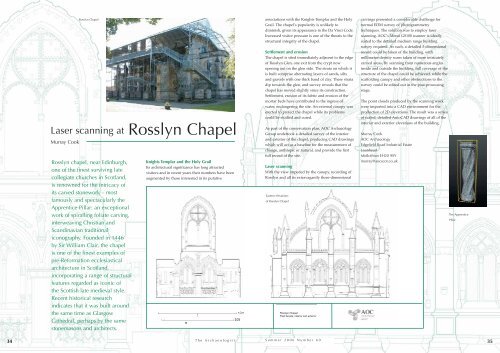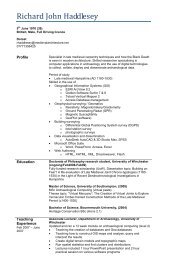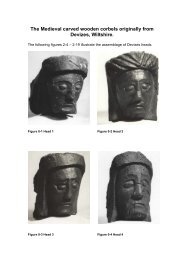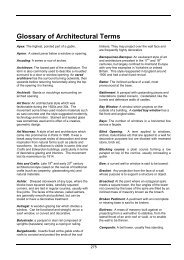The ARCHAEOLOGIST - English Late-Medieval timber-framed ...
The ARCHAEOLOGIST - English Late-Medieval timber-framed ...
The ARCHAEOLOGIST - English Late-Medieval timber-framed ...
You also want an ePaper? Increase the reach of your titles
YUMPU automatically turns print PDFs into web optimized ePapers that Google loves.
Laser scanning at<br />
Murray Cook<br />
Rosslyn Chapel<br />
Rosslyn chapel, near Edinburgh,<br />
one of the finest surviving late<br />
collegiate churches in Scotland,<br />
is renowned for the intricacy of<br />
its carved stonework – most<br />
famously and spectacularly the<br />
Apprentice Pillar: an exceptional<br />
work of spiralling foliate carving,<br />
interweaving Christian and<br />
Scandinavian traditional<br />
iconography. Founded in 1446<br />
by Sir William Clair, the chapel<br />
is one of the finest examples of<br />
pre-Reformation ecclesiastical<br />
architecture in Scotland,<br />
incorporating a range of structural<br />
features regarded as iconic of<br />
the Scottish late medieval style.<br />
Recent historical research<br />
indicates that it was built around<br />
the same time as Glasgow<br />
Cathedral, perhaps by the same<br />
stonemasons and architects.<br />
Rosslyn Chapel<br />
Knights Templar and the Holy Grail<br />
Its architectural significance has long attracted<br />
visitors and in recent years their numbers have been<br />
augmented by those interested in its putative<br />
associations with the Knights Templar and the Holy<br />
Grail. <strong>The</strong> chapel’s popularity is unlikely to<br />
diminish, given its appearance in the Da Vinci Code.<br />
Increased visitor pressure is one of the threats to the<br />
structural integrity of the chapel.<br />
Settlement and erosion<br />
<strong>The</strong> chapel is sited immediately adjacent to the edge<br />
of Rosslyn Glen, one exit from the crypt now<br />
opening out on the glen side. <strong>The</strong> strata on which it<br />
is built comprise alternating layers of sands, silts<br />
and gravels with one thick band of clay. <strong>The</strong>se strata<br />
dip towards the glen, and survey reveals that the<br />
chapel has moved slightly since its construction.<br />
Settlement, erosion of its fabric and erosion of the<br />
mortar beds have contributed to the ingress of<br />
water, endangering the site. An external canopy was<br />
erected to protect the chapel while its problems<br />
could be studied and cured.<br />
As part of the conservation plan, AOC Archaeology<br />
Group undertook a detailed survey of the interior<br />
and exterior of the chapel, producing CAD drawings<br />
which will act as a baseline for the measurement of<br />
change, anthropic or natural, and provide the first<br />
full record of the site.<br />
Laser scanning<br />
With the view impeded by the canopy, recording of<br />
Rosslyn and all its extravagantly three-dimensional<br />
Eastern elevations<br />
of Rosslyn Chapel<br />
carvings presented a considerable challenge for<br />
normal EDM survey or photogrammetry<br />
techniques. <strong>The</strong> solution was to employ laser<br />
scanning. AOC’s Mensi GS100 scanner is ideally<br />
suited to the detailed medium range building<br />
survey required. As such, a detailed 3-dimensional<br />
record could be taken of the building, with<br />
millimetre-density scans taken of more intricately<br />
carved areas. By scanning from numerous angles<br />
inside and outside the building, full coverage of the<br />
structure of the chapel could be achieved, while the<br />
scaffolding canopy and other obstructions to the<br />
survey could be edited out in the post-processing<br />
stage.<br />
<strong>The</strong> point clouds produced by the scanning work<br />
were imported into a CAD environment for the<br />
production of 2D elevations. <strong>The</strong> result was a series<br />
of scaled, detailed AutoCAD drawings of all of the<br />
interior and exterior elevations of the building.<br />
Murray Cook<br />
AOC Archaeology<br />
Edgefield Road Industrial Estate<br />
Loanhead<br />
Midlothian EH20 9SY<br />
murray@aocscot.co.uk<br />
<strong>The</strong> Apprentice<br />
Pillar<br />
34<br />
<strong>The</strong> Archaeologist<br />
Summer 2006 Number 60<br />
35





